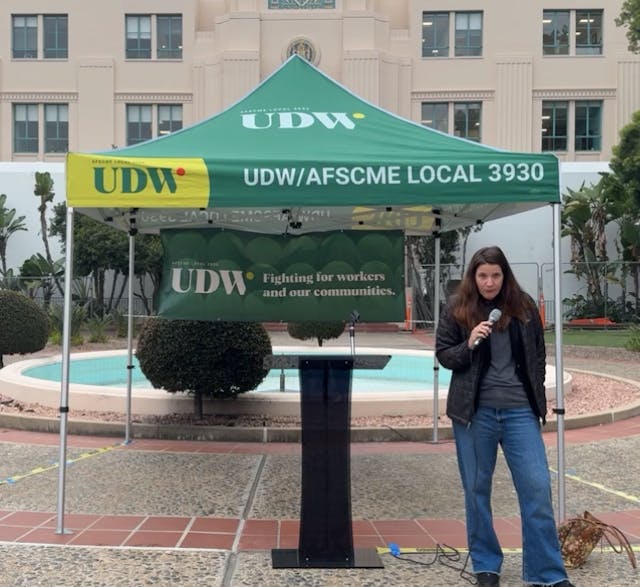The Mission to Mexico: California Governor Jerry Brown’s Diplomatic Coup
Frontera NorteSur
Largely overlooked by the U.S. media, California Governor Jerry Brown’s recent mission to Mexico may have recast the future of U.S.-Mexico relationships in a bigger way than any other U.S. leader has achieved in contemporary times.
In an agenda-packed tour of three days at the end of July, Brown not only parlayed with President Enrique Pena Nieto and other Mexican government leaders, but dialogued with Mexican and Central American bishops on immigration, signed bilateral agreements ranging from new high-tech business initiatives to curbing climate change and overall set a far different tone on border affairs than is pronounced in the crisis-ridden rhetoric dominating elite U.S. discourse.
“It’s historic. It’s extremely important that it’s coming from our governor,” said California State University (CSU) Professor Armando Vazquez Ramos. “This is what should have been in place decades ago.”
Organized by the California Chamber of Commerce, with support from the California Foundation for Commerce and Education, the delegation of an estimated 150 people that accompanied Brown gave the Mexican visit a definite economic accent. A glance at the roster of travelers reveals the interests seeking to cash in on Peña Nieto’s economic reforms. It also gives a glimpse of the direction of foreign capital investment in the Aztec Republic in the coming years. Among the companies represented on Brown’s tour de force were British Petroleum America, NRG Energy, Northrup Grumman Aerospace and Sempra Energy, the firm that’s embroiled in controversy over an alleged fraudulent land transaction in Baja California and its cozy ties with officials in Mexico and the United States.
“For California businesses, Mexico represents incredible opportunity,” Brown insisted.
According to the California Chamber of Commerce, Mexico was California’s number one trading partner in 2013, purchasing 14.2 percent of the state’s exports for a sum of $23.9 billion. Computer and electronic goods excelled as the products of choice headed across the Golden State’s border.
While the economic accords reached with Mexico- including one that allows Mexican companies access to California’s network of public-private high tech research hubs- conform with the NAFTA model, Brown’s Mexican visit went beyond a narrow business focus to create new openings for addressing outstanding, cross-border environmental, labor, immigration and education concerns.
For instance, in a letter of intent signed between Brown and the Mexican Ministry of Labor, the two parties pledged to safeguard the rights of H-2 guestworkers by making the recruitment and assignment system more transparent and accountable. A downsized successor of the old Bracero Program of Mexican guest labor, the H-2 program has been criticized by labor advocates for abusive and exploitative practices.
Notably, the H-2 agreement came at a moment when any sort of immigration reform is stuck in the Washington morass.
On the environmental front, the Brown administration and Mexican federal environmental officials agreed to develop joint action plans aimed at reducing greenhouse gases, strengthening vehicle fuel standards, promoting renewable energy and stepping up wildfire suppression efforts along the 136-mile Mexico-California border.
“Climate change increases the vulnerability of Mexico and California to extreme weather events including drought, floods, wildfires, and extreme weather temperatures, particularly at our common border, with wildfires becoming more frequent,” states the Memorandum of Understanding signed between Brown and senior officials from Mexico’s Secretariat of Natural Resources and the Environment and the National Forestry Commission.
Moreover, the agreement envisages better air quality monitoring, improving waste management in the Baja California-California corridor and allows California to enter into other agreements with individual Mexican states.
Inviting cross-border public comment on policy design and rule making processes, it also provides for personnel exchanges, training, information sharing and resource allocation. To put the potential of the new California-Mexico environmental policy framework in perspective, the agreement was consummated between a U.S. state of nearly 40 million people with an annual $2 trillion gross state product that, if independent would be the top ten economies in the world, and a nation-state approaching 120 million people which was ranked last year as the world’s 15th biggest economy ($1.26 trillion gross domestic product), according to the World Bank.
CSU Professor Vazquez, who also directs the non-profit California Mexico Studies Center in Long Beach, praised another agreement that laid the groundwork for increased academic cooperation between California and Mexican institutions of higher learning.
A longtime advocate of closer ties in academia north and south of the border, Vazquez said fostering student and faculty exchanges is at the core of futures in Mexico and the United States, as both nations increasingly demand better-educated populations in a globally competitive environment.
The exchanges that existed were disrupted in recent years when U.S. universities’ banned their students and faculty from traveling to Mexico due to concerns over violence, the researcher said. Vazquez said his own institution finally lifted such a ban last year, and small groups of CSU students and professors are just beginning to revisit Mexico again. For the California-Mexico higher education agreement to succeed, he insisted that advocates need “to hold (Brown’s) feet to the fire” so adequate resources are allocated to fund “thousands” and not hundreds of fellowships.
While he was in Mexico, Brown made statements that grabbed Mexican media attention. In a joint appearance with Mexican Foreign Minister Jose Meade, Brown distinguished himself from his indicted Texan counterpart by declaring that his administration would not militarize the border.
In a separate encounter with religious leaders, the California leader reiterated the need for a U.S. immigration reform as well as humanitarian support for children crossing the border. Besides reflecting a deepened commitment to resolving the dire circumstances of the children, the meeting with Catholic Church leaders and other officials “underscored the unique relationship between California and Mexico and Central America,” said Professor Harley Shaiken, a professor of education and geography at the University of California-Berkeley who was present for the encounter. “The state wants to ensure that the interests of the children were addressed,” Shaiken added.
According to Shaiken, a lot of advance work went into Brown’s Mexico mission, with four bilateral Memorandums of Understanding prepared ahead of time. Another outcome, he said, was a “significant amount of interaction” on the trip among business sector representatives, non-governmental activists and legislators.
CSU’s Armando Vazquez noted that Brown has signed into law about a dozen immigrant-friendly measures like driver’s licenses for undocumented persons. In comments to the Mexican Senate, Brown touched on the contentious energy reform approved by the Mexican Congress, issuing a warning to lawmakers as global energy giants prepare to conquer a newly-opened, deregulated market.
The Democratic governor urged the Mexican government to pursue “an iron hand” in regulating foreign energy corporations or risk seeing the country devoured. If appropriate regulatory measures were not put in place, Brown warned, the big energy players “will eat you alive!” As California state Senator Lou Correa, who accompanied Brown on the trip, later told Mexico’s La Jornada newspaper, the Democratic governor spoke from bitter experience.
“This is a lesson that could serve Mexico,” Correa was quoted. “With pleasure, we will share with you all the lessons that we have painfully learned.”
Correa recalled the 2000 California “energy crisis” in which Enron and other energy companies, emboldened with new power in the wake of market deregulation, concocted power shortages that caused blackouts, sent electricity rates soaring and, almost as if following a Shock Doctrine script authored by writer and analyst Naomi Klein, resulted in the recall of Democratic Governor Gray Davis and his replacement by Republican Governor Arnold Schwarzenegger.
“The 2000 energy crisis set the stage for what could be considered California’s “Lost Decade” of economic decline, housing foreclosures, out-migration and public policy austerity that saw budgets slashed and the cost of higher education soar into the galaxies. According to Vazquez, the state is barely pulling back from the edge of the abyss.
Brown’s Mexican trip tightens the bonds between neighbors with a long, common history. Conquered in a war the U.S. waged against Mexico, the native Californios were dispossessed of their lands. But more than 150 years later, the Latino population, and especially Mexican presence, has reshaped California in ever-surprising ways.
Latinos, mostly of Mexican descent but also with a sizable representation of Central and South Americans and other nationalities, now comprise 39 percent of the state’s population and are expected to surpass whites as the largest state ethnic group this year, the Pew Research Center projects.
Different regions of California are characterized by the transplanting of virtually entire communities from Mexican states like Oaxaca or Michoacan. At least eight California cities now host annual celebrations of Guelaguetza, the indigenous Oaxacan festival.
Conversely, a significant population of California and U.S. expatriates has settled on Mexico’s West Coast, where Thanksgiving Day celebrations are now held, their dinners even prepared many times by Mexican cooks who learned the menu while working in the United States.
Culturally, the California- Mexico connection has fostered a dynamic fusion in cuisine, the plastic arts, cinema, literature, language and music. While the U.S. Silver Screen attracted Mexican actors and actresses like Antonio Aguilar and Dolores del Rio, the so-called “Hollywood Gang” of John Wayne, Dean Martin, Sammy Davis Jr. and friends made frequent visits to Acapulco. Johnny Weismuller, the iconic Tarzan of Hollywood, is buried in Acapulco, where he lived out his last years.
In popular music the surrealistic guitar leads of Mexican immigrant Carlos Santana added a Latin flavor to the San Francisco rock of the 1960s, while the sounds of the East Los Angeles Chicano combo Los Lobos blended rock, blues, folk, polka and traditional Mexican ballads in a street gritty but stunningly stellar creation that might be called “Mex-Americana.” For a younger generation, 2014 Grammy Award winners La Santa Cecilia, formed by young Mexican-Americans from Los Angeles, synthesize the California-Mexico musical/cultural scene with bilingual lyrics and influences ranging from rock to cumbia to norteno, evident in tunes like the group’s accordion-laced cover of the Beatles “Strawberry Fields Forever,” which forms the sound-track of a psychedelic-like cartoon video starring farmworkers harvesting one of California’s major crops.
La Santa Cecilila’s acclaimed song “Ice El Hielo” is an anthem of the times. Capturing the realities of millions of California and U.S. immigrants, the tune can be heard on YouTube accompanied by video that portrays a young female restaurant worker confronted by a militarized raiding party from U.S. Immigration and Customs Enforcement. Perhaps not surprisingly, one of La Santa Cecilia’s members recently “outed” himself as undocumented.
For Vazquez, the California-Mexico accords are a catch-up to demographic and economic realities that transformed two important places on the planet while Washington and Mexico City were preoccupied with other matters. Now, it remains to be seen if the 2014 agreements could represent far-reaching shifts in the politics of U.S.-Mexico relations on both sides of the border.
“Ironically, I think under this (Mexican) PRI government there are better conditions for collaboration,” Vazquez said. “Neither (former presidents) Fox nor Calderon had any moxy, or expertise, to grow the relationship with California.”
On the other side of the diplomatic coin, the July 2014 agreements differ from the main thrusts of Washington’s Mexican and Latin American policies of recent administrations which, according to Vazquez, have centered on the “policing policies” of Plan Colombia or Plan Merida (Mexico), the U.S. anti-drug strategy first implemented during the Bush administration and continued under the Obama White House.






